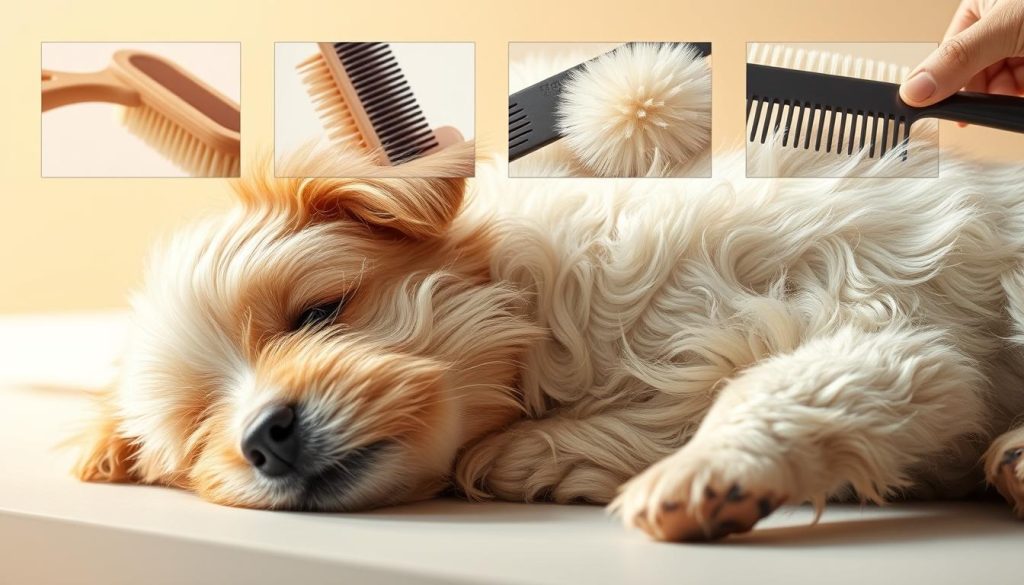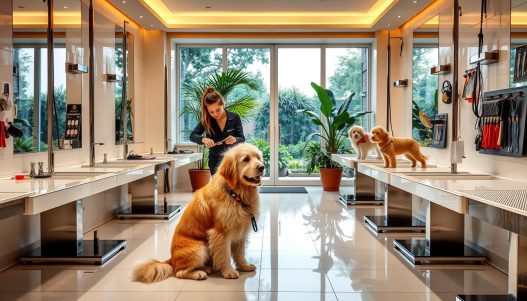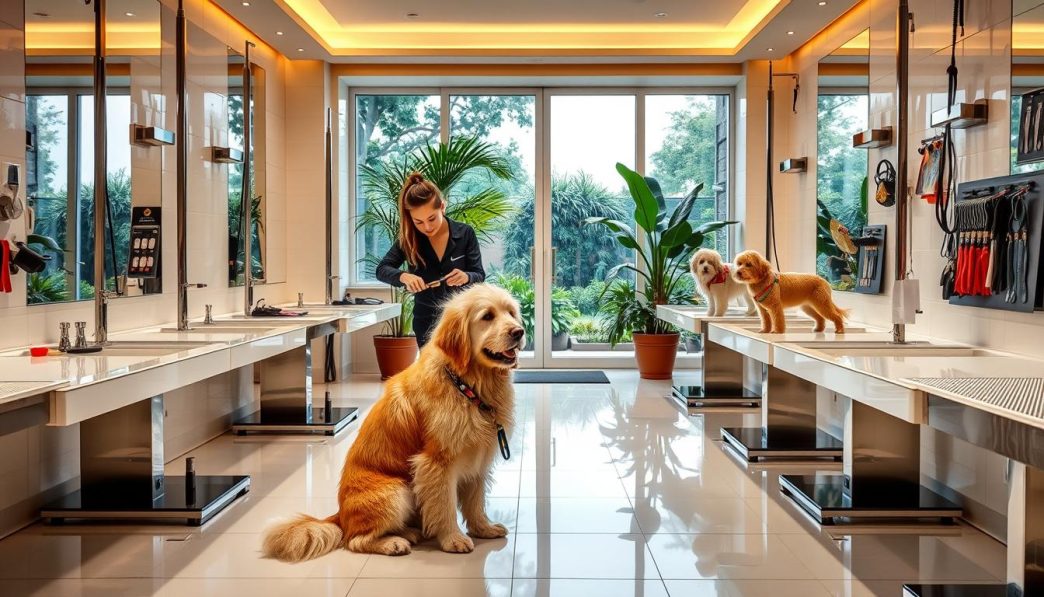Dog grooming is key to pet care. It greatly affects your dog’s health and happiness.
Regular pet grooming stops health problems, lowers stress, and makes your bond stronger. It’s more than just making your dog look good. It’s about their happiness too.
This article will share pet grooming tips to make your dog’s life better. You’ll learn the main dog grooming practices for a healthy dog.
Key Takeaways
- Understand the importance of regular dog grooming for your dog’s health.
- Learn essential pet grooming tips to prevent health issues.
- Discover how grooming can strengthen the bond between you and your dog.
- Find out how to keep your dog happy and healthy through proper grooming.
- Get an overview of the best dog grooming practices.
The Importance of Regular Pet Grooming
Regular pet grooming is key for your dog’s health and happiness. It’s not just about looks. It’s vital for their overall well-being.
Health Benefits of Proper Grooming
Proper grooming keeps your dog healthy. It prevents matting, reduces shedding, and improves their coat. It also lets you check for health issues like skin problems or parasites.
- Reduced risk of skin problems
- Early detection of health issues
- Improved coat health
Psychological Benefits for Your Dog
Grooming is good for your dog’s mind too. It can calm them and reduce stress. It also makes your bond stronger, building trust and happiness.
Some benefits include:
- Reduced stress and anxiety
- Increased trust between dog and owner
- Improved emotional well-being
Essential Pet Grooming Tools Every Owner Should Have
To keep your dog looking and feeling its best, you’ll need a variety of essential grooming tools. The right equipment can make a big difference in your dog’s health and happiness.
Basic Brushes and Combs for Different Coat Types
Different coat types need specific brushes and combs. For example, slicker brushes are great for long-haired breeds to remove tangles and mats. On the other hand, bristle brushes are better for short-haired dogs. They help distribute skin oils and keep their coat shiny.
Bathing Supplies and Shampoos
Bathing is a key part of dog grooming. You’ll need a good quality shampoo that fits your dog’s skin type. For dogs with sensitive skin, hypoallergenic shampoos are a good choice. Also, having a conditioner can help keep their coat healthy and easy to manage.
Nail Care Tools and Safety Equipment
Nail care is often overlooked in dog grooming. Nail clippers or grinders are needed to keep your dog’s nails healthy. It’s also crucial to have styptic powder ready to stop any bleeding if you accidentally cut the quick.
| Grooming Tool | Purpose | Suitable For |
|---|---|---|
| Slicker Brush | Removing tangles and mats | Long-haired breeds |
| Bristle Brush | Distributing skin oils | Short-haired dogs |
| Nail Clippers/Grinders | Trimming nails | All breeds |
Understanding Your Dog’s Coat Type
Knowing your dog’s coat type is key for good grooming. Each breed has its own coat type that needs special care. By figuring out your dog’s coat type, you can pick the best grooming tools and methods.
Short-Haired Breeds: Maintenance Tips
Short-haired dogs, like Beagles and Boxers, have a simple coat that needs little grooming. Still, they should be brushed regularly to get rid of dead hair and spread skin oils. A rubber grooming mitt or a soft-bristle brush works well for this.
Bathing should be done when needed, usually every few months. Use a mild shampoo that’s right for their skin.
Long-Haired Breeds: Preventing Mats and Tangles
Long-haired dogs, such as Afghan Hounds and Shih Tzus, need more grooming. Their long, beautiful coats can easily get matted and tangled. So, they need to be brushed every day.
Use a slicker brush or a pin brush to gently remove tangles, starting from the ends. Regular brushing keeps their coat looking great and prevents mats. Trimming around the eyes, ears, and paws also helps keep them looking neat.
Double-Coated Breeds: Dealing with Shedding
Double-coated breeds, such as Siberian Huskies and Golden Retrievers, have a thick undercoat and a coarser outer coat. They shed a lot, especially during shedding season. They need regular grooming to manage their shedding.
Use an undercoat rake or a shedding tool to get rid of dead undercoat and cut down on shedding. Brushing them regularly also helps prevent matting and keeps their coat healthy. Bathe them as needed, using a shampoo made for their coat type.
Brushing Techniques: Pet Grooming Tips for a Happy, Healthy Pup
Brushing your dog is more than just a routine task. It’s key to their grooming and health. Regular brushing stops matting and tangling, cuts down on shedding, and spreads skin oils. This makes their coat healthy and shiny.
How Often to Brush Different Coat Types
The brushing frequency varies by your dog’s coat type. Short-haired breeds need a weekly brush. Long-haired breeds should brush daily to avoid mats and tangles. Double-coated breeds need regular brushing, especially when they shed a lot.
- Short-haired breeds: Weekly brushing
- Long-haired breeds: Daily brushing
- Double-coated breeds: Regular brushing, especially during shedding season
Step-by-Step Brushing Guide for Maximum Comfort
Start by picking the right brush for your dog’s coat. Begin brushing gently, from head to tail. Focus on areas that easily mat. Use slow, gentle strokes and be patient, especially around sensitive spots.

Dealing with Mats and Tangles Safely
When you find mats or tangles, be gentle to avoid hurting your dog. Use a detangling spray or conditioner to help. Work from the end of the hair towards the root. For really bad matting, get professional help.
Key tips for dealing with mats and tangles:
- Use a detangling spray or conditioner
- Work gently from the end of the hair towards the root
- Consider professional help for severe matting
Bathing Your Dog: Best Practices
Regular baths are key to your dog’s health and happiness. They clean off dirt and spread skin oils. This keeps their coat shiny and healthy.
How Often Should You Bathe Your Dog
How often you bathe your dog depends on several things. This includes their breed, coat type, and how active they are. Dogs that go outside a lot might need baths more often than those that stay inside.
Short-haired dogs usually need baths less than long-haired ones.
Choosing the Right Shampoo for Your Dog’s Skin Type
Choosing the right shampoo is very important. It helps avoid skin irritation. Dogs with sensitive skin do well with hypoallergenic shampoos. Those with skin problems might need medicated shampoos.
Always check the label for pH-balanced shampoos made for dogs.
The Bathing Process: From Preparation to Drying
Start by brushing your dog to prevent mats. Use lukewarm water and a gentle shampoo, avoiding their eyes and ears. Rinse well to get rid of all soap.
After bathing, dry your dog completely. Pay special attention to their ears to prevent infections.
By following these tips, bath time can be a good experience for your dog. It helps keep them healthy and strengthens your bond.
Nail Care and Paw Maintenance
Keeping your dog’s nails and paws in good shape is key for their health and happiness. Long nails can hurt and cause health problems. Not taking care of their paws can lead to dry, cracked pads.
Signs Your Dog Needs a Nail Trim
It’s important to know when your dog needs a nail trim. Look for signs like clicking sounds on hard floors, long nails, or if they’re limping or seem uncomfortable.
How to Safely Trim Your Dog’s Nails Without Stress
Trimming your dog’s nails needs patience and care. First, get them used to having their paws handled. Use a good clipper or grinder, and only trim the tip of the nail. If you’re not sure, ask a vet or groomer for help.
Paw Pad Care: Protection and Moisturizing
Caring for your dog’s paw pads means protecting them and keeping them moist. Use paw balm or wax, especially in dry or cold weather. Always check their paws for any damage or irritation.
| Nail Care Tips | Paw Pad Care Tips |
|---|---|
| Trim nails regularly | Moisturize paw pads regularly |
| Avoid cutting the quick | Protect paws from harsh surfaces |
| Use proper nail clippers | Inspect paws for damage regularly |
Professional vs. At-Home Grooming
Choosing between professional grooming and at-home grooming depends on your dog’s breed, coat type, and grooming needs. Each option has its own benefits.
When to Seek Professional Help
If your dog has a complex coat or needs special grooming, go for professional grooming. Professional groomers know how to handle different breeds and coats. They ensure your dog gets the best care.
What to Expect at a Professional Grooming Session
At a professional grooming session, your dog will get a full check-up, bath, trim, and nail care. The groomer will also look for skin issues or health problems. This gives you important information as a dog owner.
Cost-Saving Tips for At-Home Maintenance
If you prefer at-home grooming, here are some cost-saving tips. Buying good grooming tools, like quality brushes and nail clippers, can cut down on professional grooming costs. Regular brushing and nail trimming prevent matting and health issues.
Knowing the pros and cons of both professional and at-home grooming helps you choose what’s best for your dog and your wallet.
Handling Grooming Anxiety and Difficult Dogs
Grooming can be scary for many dogs, leading to anxiety and fear. It’s important to recognize stress signs and use positive reinforcement to help.
Recognizing Signs of Stress During Grooming
Dogs show stress in different ways, like panting, yawning, and avoiding eye contact. Knowing these signs helps owners adjust their grooming methods.
- Panting or rapid breathing
- Yawning or licking lips
- Avoiding eye contact or hiding
Positive Reinforcement Techniques
Positive reinforcement is key in reducing grooming anxiety. By linking grooming to rewards, dogs feel more at ease.
Effective methods include giving treats, using a soothing voice, and slowly introducing grooming tools.
Building a Grooming Routine Your Dog Will Love
Creating a regular grooming routine makes dogs more comfortable. Start with short sessions and gradually increase the time.
| Grooming Activity | Frequency | Tips |
|---|---|---|
| Brushing | Daily | Use gentle strokes and soft brushes |
| Nail Trimming | Weekly | Use nail clippers specifically designed for dogs |
| Bathing | Monthly | Use lukewarm water and dog-friendly shampoos |
Conclusion: Creating a Positive Grooming Experience
Creating a positive grooming experience is key for your dog’s happiness. By following the grooming tips in this article, you can make grooming a fun time for your dog.
Regular grooming keeps your dog looking great and strengthens your bond. It also lets you check on their health. A positive grooming experience comes from knowing your dog’s coat type, using the right tools, and watching for signs of stress.
By using these tips, you can make grooming a positive and enjoyable time for your dog. This helps build a strong and happy relationship between you and your pet.






